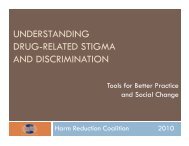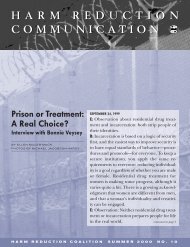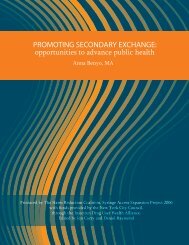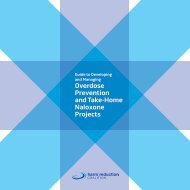9th - Harm Reduction Coalition
9th - Harm Reduction Coalition
9th - Harm Reduction Coalition
Create successful ePaper yourself
Turn your PDF publications into a flip-book with our unique Google optimized e-Paper software.
<strong>9th</strong><br />
National <strong>Harm</strong> <strong>Reduction</strong> Conference<br />
FROM PUBLIC HEALTH TO SOCIAL JUSTICE<br />
Neil Flynn, M.D., M.P.H. has focused most of his nearly 40 year career in medicine on treatment and prevention of HIV/AIDS - primarily<br />
among drug users. As a result of working with drug users, he has developed a growing interest in buprenorphine substitution<br />
therapy for opiate dependence. He is an advocate for drug user rights, and believes strongly in decriminalization of drug use<br />
as much as possible, replacing it with a public health, medical, and psychosocial model. He considers the current criminalization<br />
model a violation of human rights, and decries its racist and classist policies. Dr. Flynn received his undergraduate degree from<br />
UCLA in bacteriology in 1970, his medical degree from Ohio State University in 1973, completed his residency in internal medicine<br />
at Loma Linda University in 1976, his specialty training in infectious diseases from the University of California Davis, and his<br />
master of public health degree from UC Berkeley in 1995. He has published articles in peer-reviewed journals on the topics of<br />
hospital-acquired infection, various infectious diseases including MRSA, and HIV/AIDS treatment and prevention. He retired from<br />
UC Davis in 2009.<br />
Formo, Samuel, St.James Infirmary, San Framcisco, CA<br />
samislick@yahoo.com<br />
Satellite Syringe Exchange: Building Collaboration<br />
As an answer to getting clean syringes to IDUs who cannot access syringe exchange programs (SEPs), many providers have<br />
set up participants as satellite syringe exchangers (SSE). To reach out further and get clean syringes to underserved communities,<br />
we can improve our SSE programs through collaboration. In San Francisco, all SEPs are now under one contract,<br />
working collectively to provide underserved neighborhoods, build alliances with law enforcement and city residents and assess<br />
the real needs of community members. Using this as a model for developing an SSE collaborative, it seems essential<br />
that SSE participants should come together, share their knowledge, gain some new tools with which to feel empowered and<br />
become leaders in their endeavors. The purpose of this workshop is to help HRC attendees come up with ways to widen syringe<br />
distribution, empower SSE participants and continue dialogue around the importance of SSE programs. This workshop<br />
will feature statistics showing how many people are served by SSE participants in contrast to how many are served at fixed<br />
sites. There will be a discussion on what makes a collaborative work and how to manage challenges as they arise. Surveys<br />
conducted among SSE’s will illustrate the success of this effort.<br />
Sam Formo is the Syringe Access and Disposal Program Coordinator at St. James Infirmary, an occupational health and safety<br />
clinic for current and former sex workers. Sam’s dedication to providing harm reduction options and overdose prevention strategies<br />
to active drug users is rooted in the belief that this population deserves human rights as much as anybody else. Sam has<br />
implemented and maintained a satellite syringe exchange program and is currently working on building an SSE collaborative.<br />
Frost, Taeko, Washington Heights CORNER Project (WHCP), NY, NY<br />
taeko@cornerproject.org<br />
Participant Bathroom Management<br />
Drug users get high in public bathrooms, perhaps especially if the bathroom is in a syringe exchange program. As program<br />
staff, how do we maintain an accessible, safe space for participants and still protect fellow participants and staff from needle<br />
stick injury, blood exposure and septic system shut down How do we monitor the bathrooms to prevent fatal overdose<br />
Striking the balance between access, safety, and efficiency is challenging: what has and hasn’t worked in your program<br />
What message about drug use in the bathroom does your program communicate and in what way We invite attendees to<br />
share their experiences at this round table to critically think about your program and what could be done better to protect<br />
participants and staff. This discussion may be particularly helpful for staff who are working in new programs or programs<br />
that have added syringe exchange to an existing program that may not have the knowledge and experience of those in the<br />
room. We hope that this conversation will be the first of many to continually work to support participant and staff safety<br />
around participant bathroom management in the context of SIFs being illegal.<br />
42











